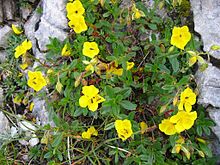Helianthemum nummularium (known as common rock-rose[2]) is a species of rock-rose (Cistaceae), native to most of Europe.
| Helianthemum nummularium | |
|---|---|

| |
| Helianthemum nummularium subsp. glabrum | |
| Scientific classification | |
| Kingdom: | Plantae |
| Clade: | Tracheophytes |
| Clade: | Angiosperms |
| Clade: | Eudicots |
| Clade: | Rosids |
| Order: | Malvales |
| Family: | Cistaceae |
| Genus: | Helianthemum |
| Species: | H. nummularium
|
| Binomial name | |
| Helianthemum nummularium | |
| Synonyms[1] | |
|
List
| |

Description edit
It is an evergreen trailing plant with loose terminal clusters of bright yellow, saucer-shaped flowers. In the flower centre is a tight cluster of orange stamens, which are sensitive to the touch, and spread outwards to reveal the tall stigma in the middle. The plant is common on chalk downs, and occasional in other grasslands, always on dry, base-rich soil. The wild species has yellow flowers, but garden varieties range from white through yellow to deep red.
Though the individual blooms are short-lived, the plant produces a mass of flowers through the summer. It needs a dry, sunny place, like a south-facing rockery or meadow. As the Latin name Helianthemum suggests, these are sun-flowers. This is a good pollen source for bees and there are several species of small beetle that feed on the foliage. Common rock-rose is also the food plant for the larvae of several species of moth and butterfly such as the silver-studded blue (Plebejus argus).
It flowers from May until July.
Taxonomy edit
Subspecies edit
Two subspecies are currently accepted:[1]
- Helianthemum nummularium subsp. kerneri (Gottl.-Tann. & Janch.) Lambinon
- Helianthemum nummularium subsp. nummularium. Widespread.
Gallery edit
subsp. grandiflorum (Scop.) Schinz & Thell. edit
subsp. nummularium edit
subsp. obscurum (Čelak.) Holub) edit
-
H. nummularium subsp. obscurum
Germany - Schwäbisch Fränkische Waldberge -
H. nummularium subsp. obscurum
Germany - Schwäbisch Fränkische Waldberge -
H. nummularium subsp. obscurum
Germany - Schwäbische Alb -
H. nummularium subsp. obscurum
Germany - Schwäbische Alb
Pink-flowered cultivars edit
Illustrations edit
-
flower diagram
Unclassified images of Helianthemum nummularium edit
References edit
- ^ a b "Helianthemum nummularium (L.) Mill". Plants of the World Online. Board of Trustees of the Royal Botanic Gardens, Kew. 2017. Retrieved 12 December 2020.
- ^ BSBI List 2007 (xls). Botanical Society of Britain and Ireland. Archived from the original (xls) on 2015-06-26. Retrieved 2014-10-17.